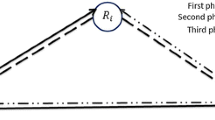Abstract
In this paper, we present analytical expressions for the outage probability, average symbol error rate (SER), and average sum-rate of two-way dual-hop opportunistic amplify-and-forward (AF) relaying over independent and not necessarily identical generalized-k (KG) fading channels. New closed-form expression for the gain of non-regenerative semi-blind relays is derived. This expression is used to obtain the equivalent signal-to-noise ratio (SNR). Based on the above mentioned formulas, tight bounds of some performance metrics, the outage probability, average SER, and average sum-rate, are derived for the semi-blind and channel state information (CSI) relaying. In order to prove the exactness of the proposed mathematical analysis, a selection of numerical results is provided.








Similar content being viewed by others
References
Paulraj A, Nabar R, Gore D (2003) Introduction to space-time wireless communications, 1st edn. Cambridge University Press, Cambridge, UK
Shankar PM (2004) Error rates in generalized shadowed fading channels. Wireless Pers Commun 28(4):233–238
Chitroub S, Houacine A, Sansal B (2002) Statistical characterization and modelling of SAR images. Wireless Pers Commun, Elsevier, Signal Process 82(1):69–92
Peppasa KP, Datsikasb CK, Nistazakisb HE, Tombras GS (2010) Dual-hop relaying communications over generalized-K (KG) fading channels. J Frankl Inst, Elsevier 347(9):1643–1653
Peppas KP, Stassinakis AN, Nistazakis HE, Tombras GS (2013) Capacity analysis of dual amplify-and-forward relayed free-space optical communication systems over turbulence channels with pointing errors. IEEE/OSA J Opt Commun Netw 5(9):1032–1042
Safari M, Uysal M (2008) Relay-assisted free-space optical communication. IEEE Trans Wirel Commun 7(12):5441–5449
Bithas P., Sagias N, Mathiopoulos P, Karagiannidis G, Rontogiannis A (2006) On the performance analysis of digital communications over generalized-k fading channels. IEEE Commun Lett 10:3535
Bithas PS, Mathiopoulos PT, Kotsopoulos S (2007) Diversity reception over generalized-K (KG)fading channels. IEEE Trans Wireless Commun 6:423843
Laourine A, Alouini M, Affes S, Stephenne A (2008) On the capacity of generalized-K fading channels. IEEE Trans Wireless Commun 7:24415
Peppas K, Lazarakis F, Alexandridis A, Dangakis K (2010) Cascaded generalised-K fading channel. IET Commun 4(1):116–124
Wu L, Lin J, Niu K, He Z (2009) Performance of dual-hop transmissions with fixed gain relays over generalized-k fading channels. In: Proceedings of the ICC, Dresden, p 37303735
Datsikas CK, Peppas KP, Lazarakis FI, Tombras GS (2009) Error rate performance analysis of dual-hop relaying transmissions over generalized-k fading channels. AEU Int J Electron Commun. doi:10.1016/j.aeue.2009.09.005
Zafar A, Radaydeh RM, Chen Y, Alouini M-S (2012) Energy-efficient power allocation for fixed-gain amplify-and-forward relay networks with partial channel State information. IEEE Wireless Commun Lett 1(6)
Larsson P, Johansson N, Sunell KE (2006) Coded bi-directional relaying. In: Proceedings of the IEEE vehicles technology conference (VTC06-Spring), pp 851–855
Rankov B, Wittneben A (2007) Spectral efficiency protocols for halfduplex fading relay channels. IEEE J Select Areas Commun 25(2):379–389
Rankov B, Wittneben A (2005) Spectral efficient signaling for half-duplex relay channels. In: Proceedings of the Asilomar conference on signals, systems, and computers, Pacific Grove
Hwang K-S, Ko Y-C, Alouini M-S (2009) Performance bounds for two-way amplify-and-forward relaying based on relay path selection. In: 69th IEEE vehicular technology conference VTC Spring
Hadj Alouane W, Hamdi N, Meherzi S (2014) Semi-blind amplify-and-forward in two-way relaying networks. Ann Telecommun, Springer 69(9–10):497–508
Hadj Alouane W, Hamdi N (2014) Semi-blind two-way AF relaying over Nakagami-m fading environment. Ann Telecommun, Springer. doi:10.1007/s12243-014-0427-6
Han Y, Ting SH, Ho CK, Chin WH (2008) High rate two-way amplify-and-forward half-duplex relaying with OSTBC. In: Proceedings of IEEE VTC 08Spring, pp 2426– 2430
Hasna MO, Alouini M-S (2004) A performance study of dual-hop transmissions with fixed gain relays. IEEE Trans Wireless Commun 3(6):1963–1968
Gradshteyn IS, Ryzhik IM (2000) Table of integrals, series, and products, 6th edn. Academic Press, New York
Adamchik VS, Marichev OI (1990) The algorithm for calculating integrals of hypergeometric type functions and its realization in REDUCE system. In: Proceedings of the International conference symbolic and algebraic computing, Tokyo, pp 212–224
Gradshteyn IS, Ryzhik IM (1994) Table of integrals, series, and products, 5th edn. Academic, San Diego
Abramowitz M, Stegun IA (1972) Handbook of mathematical functions with formulas, graphs, and mathematical tables, 9th edn. Dover, New York
Author information
Authors and Affiliations
Corresponding author
Appendices
Appendix A
The upper bound for the average sum-rate of semi-blind opportunistic AF relaying over generalized-k fading channels can be written as [18]
where f γ (t) is the PDF of γ given as \(\gamma =max\left (\gamma _{1},\ldots ,\gamma _{L}\right )\). By doing some manipulations, Eq. 50 can be rewritten as
The above equation can be written in the form \({\int }_{0}^{\infty } \exp (-x)g(x)dx\) by multiplying and dividing it with \(\exp (x)\). Where \(g(x)= \exp (x) f(x)\). Therefore, it can be solved using the Gauss-Laguerre quadrature as
Appendix B
The upper bound for the average sum-rate of CSI-assisted opportunistic AF relaying over generalized-k fading channels can be written as [17]
where f γ (t) is the PDF of γ given as \(\gamma =max\left (\gamma _{1},\ldots ,\gamma _{L}\right )\). After simple mathematical manipulations, the Eq. 53 can be rewritten as
which can be evaluated by the same method presented in Eq. 52 as
Rights and permissions
About this article
Cite this article
Hadj Alouane, W., Hamdi, N. Performance analysis of semi-blind two-way AF relaying over generalized-k fading channels. Ann. Telecommun. 70, 381–394 (2015). https://doi.org/10.1007/s12243-015-0460-0
Received:
Accepted:
Published:
Issue Date:
DOI: https://doi.org/10.1007/s12243-015-0460-0




